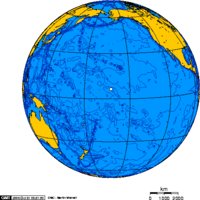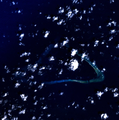
Kingman Reef
Encyclopedia


Pacific Ocean
The Pacific Ocean is the largest of the Earth's oceanic divisions. It extends from the Arctic in the north to the Southern Ocean in the south, bounded by Asia and Australia in the west, and the Americas in the east.At 165.2 million square kilometres in area, this largest division of the World...
, roughly half way between the Hawaiian Islands
Hawaiian Islands
The Hawaiian Islands are an archipelago of eight major islands, several atolls, numerous smaller islets, and undersea seamounts in the North Pacific Ocean, extending some 1,500 miles from the island of Hawaii in the south to northernmost Kure Atoll...
and American Samoa
American Samoa
American Samoa is an unincorporated territory of the United States located in the South Pacific Ocean, southeast of the sovereign state of Samoa...
at 6°23′N 162°25′W. It is the northernmost of the Northern Line Islands
Line Islands
The Line Islands, Teraina Islands or Equatorial Islands, is a chain of eleven atolls and low coral islands in the central Pacific Ocean, south of the Hawaiian Islands, that stretches for 2,350 km in a northwest-southeast direction, making it one of the longest islands chains of the world...
and lies 36 nautical miles (66.7 km) northwest of the next closest island (Palmyra Atoll
Palmyra Atoll
Palmyra Atoll is an essentially unoccupied equatorial Northern Pacific atoll administered as an unorganized incorporated territory by the United States federal government...
), and 930 nautical miles (1,722.4 km) south of Honolulu.
The reef encloses a lagoon
Lagoon
A lagoon is a body of shallow sea water or brackish water separated from the sea by some form of barrier. The EU's habitat directive defines lagoons as "expanses of shallow coastal salt water, of varying salinity or water volume, wholly or partially separated from the sea by sand banks or shingle,...
up to 270 feet (82.3 m) deep in its western part. The total area within the outer rim of the reef is 76 square kilometre. There are two small strips of dry land composed of coral rubble and giant clamshells on the eastern rim with areas of 2 acres (8,093.7 m²) and 1 acres (4,046.9 m²) having a coastline of 3 kilometres (1.9 mi). The highest point on the reef is less than 5 feet (1.5 m) above sea level, which is wetted or awash most of the time, making Kingman Reef a maritime hazard. It has no natural resources and supports no economic activity.
Political status
Kingman Reef has the status of an unincorporated U.S. possession of the United StatesUnited States
The United States of America is a federal constitutional republic comprising fifty states and a federal district...
, administered from Washington, DC by the U.S. Department of Interior. The atoll is closed to the public. For statistical purposes, Kingman Reef is grouped as part of the United States Minor Outlying Islands
United States Minor Outlying Islands
The United States Minor Outlying Islands, a statistical designation defined by the International Organization for Standardization's ISO 3166-1 code, consists of nine United States insular areas in the Pacific Ocean and Caribbean Sea: Baker Island, Howland Island, Jarvis Island, Johnston Atoll,...
. In January 2009, Kingman Reef was designated a marine national monument.
The pre-20th century names Danger Reef, Caldew Reef, Maria Shoal and Crane Shoal refer to this atoll, which by then was entirely submerged at high tide. Thomas Hale Streets
Thomas Hale Streets
Thomas Hale Streets was an American naturalist. His works include Contributions to the Natural History of the Hawaiian and Fanning Islands and Lower California ....
described its state in the 1870s, when it had:
... hardly, as yet, assumed the distinctive features of an island. It is entirely under water at high tide, and but a few coral heads project here and there above the surface at low water. In the course of time, however, it will undoubtedly be added to the [northern Line Islands].
History
Kingman Reef was discovered by the American Captain Edmund FanningEdmund Fanning
Edmund Fanning was an American explorer and sea captain, known as the "Pathfinder of the Pacific."-Life:...
of the ship Betsey on June 14, 1798. Captain W. E. Kingman (whose name the island bears) described it on November 29, 1853. It was claimed for the United States under the name "Danger Reef" by the Guano Islands Act
Guano Islands Act
The Guano Islands Act is federal legislation passed by the U.S. Congress, on August 18, 1856. It enables citizens of the U.S. to take possession of islands containing guano deposits. The islands can be located anywhere, so long as they are not occupied and not within the jurisdiction of other...
of 1856.
Lorrin A. Thurston
Lorrin A. Thurston
Lorrin Andrews Thurston was a lawyer, politician, and businessman born and raised in the Kingdom of Hawaii. The grandson of two of the first Christian missionaries to Hawaii, Thurston played a prominent role in the overthrow of the Hawaiian Kingdom that replaced Queen Liliuokalani with the...
formally annexed Kingman to the United States on May 10, 1922 by reading this declaration on shore:
Be it known to all people: That on the tenth of May, A.D. 1922, the undersigned agent of the Island of Palmyra Copra Co., Ltd., landed from the motorship Palmyra doth, on this tenth day of May, A.D. 1922, take formal possession of this island, called Kingman Reef, situated in longitude 162 degrees 18' west and 6 degrees 23' north, on behalf of the United States of America and claim the same for said company.
The lagoon was used in 1937 and 1938 as a halfway station between Hawai'i
Hawaii
Hawaii is the newest of the 50 U.S. states , and is the only U.S. state made up entirely of islands. It is the northernmost island group in Polynesia, occupying most of an archipelago in the central Pacific Ocean, southwest of the continental United States, southeast of Japan, and northeast of...
and American Samoa by Pan American Airways
Pan American World Airways
Pan American World Airways, commonly known as Pan Am, was the principal and largest international air carrier in the United States from 1927 until its collapse on December 4, 1991...
flying boat
Flying boat
A flying boat is a fixed-winged seaplane with a hull, allowing it to land on water. It differs from a float plane as it uses a purpose-designed fuselage which can float, granting the aircraft buoyancy. Flying boats may be stabilized by under-wing floats or by wing-like projections from the fuselage...
s (Sikorsky S-42B
Sikorsky S-42
|-See also:-References:NotesBibliography* Davies, R.E.G. Pan Am: An Airline and its Aircraft. New York: Orion Books, 1987. ISBN 0-517-56639-7....
). Pan Am wanted to expand flights into the Pacific and include Australia and New Zealand to their "Clipper" air routes. In 1935 it was decided that the lagoon at Kingman Reef was suitable for overnight stops en route from the U.S to New Zealand via Samoa. Kingman Reef became the stopover to and from Pago Pago, American Samoa, located 1600 miles (2,574.9 km) further south. A supply ship, the North Wind, was stationed at Kingman Reef to provide fuel, lodging, and meals. The S42B Pan American Clipper II, piloted by Captain Edwin Musick, landed at Kingman on its first flight on March 23, 1937. Several successful flights followed, however the flight on January 11, 1938 ended in tragedy. Shortly after the early morning take off from Pago Pago, bound for New Zealand the Clipper exploded. The right outboard engine developed an oil leak and the plane burst into flames while dumping fuel, and there were no survivors. As a result of the tragedy, Pan Am ended flights to New Zealand via Kingman Reef and Pago Pago. A new route was established in July 1940 by way of Canton Island and New Caledonia.
On December 29, 1934 the US Navy assumed jurisdiction over Kingman Reef. On September 1, 2000 the Navy relinquished its control over Kingman Reef to the US Department of the Interior and on January 18, 2001 the Secretary of the Interior signed Secretary’s Order 3223 establishing Kingman Reef as a National Wildlife Refuge including 1958 km² (483,831.9 acre). The National Wildlife Refuge is composed of the emergent coral rubble spits and all waters out to 12 nautical miles (22.2 km). In January 2009, Kingman Reef was designated a marine national monument.
Amateur radio expeditions
Since the early 1940s Kingman Reef has had very little human contact, though amateur radioAmateur radio
Amateur radio is the use of designated radio frequency spectrum for purposes of private recreation, non-commercial exchange of messages, wireless experimentation, self-training, and emergency communication...
operators from around the world have occasionally visited the reef to put it "on the air" in what is known as a DX-pedition
DX-pedition
A DX-pedition is an expedition to what is considered an exotic place by amateur radio operators, perhaps because of its remoteness or because there are very few radio amateurs active from that place. This could be an island, a country, or even a particular spot on a geographical grid.The activity...
. In 1974, a group of amateurs using the callsign KP6KR sailed to the reef and set up a temporary radio station and antenna tower. Other groups visited the island in subsequent years, including 1977, 1980, 1981, 1988 and 1993.
Most recently, a group of 15 amateur radio operators from the Palmyra DX Group visited the reef in October 2000. Using the FCC-issued special event callsign K5K, the group made more than 80,000 individual contacts with amateurs around the world over a period of 10 days.
Ecology

Giant clam
The giant clam, Tridacna gigas , is the largest living bivalve mollusc. T. gigas is one of the most endangered clam species. It was mentioned as early as 1825 in scientific reports...
s are abundant in the shallows, and there are approximately 38 genera and 130 species of stony corals present on the reef. This is more than three times the species diversity of corals found in the main Hawaiian Islands. The ecosystem of the reef and its subsequent food chain are known for the distinct quality of being primarily predator-based. The percentage of the total fish biomass on the reef is made up of 85% apex predators, creating a high level of competition for food and nutrients among local organisms — particularly sharks, jacks and other carnivores. The threatened green sea turtles that frequent nearby Palmyra atoll travel to Kingman Reef to forage and bask on the coral rubble spits at low tide.
Above sea level the reef is usually barren of macroorganisms, however. Mainly constructed of dead and dried coral skeletons, providing only calcite
Calcite
Calcite is a carbonate mineral and the most stable polymorph of calcium carbonate . The other polymorphs are the minerals aragonite and vaterite. Aragonite will change to calcite at 380-470°C, and vaterite is even less stable.-Properties:...
as a source of nutrients, the small and narrow strips of dry land are only habitable by a handful of species for short periods of time. Most flora which begin to grow above water — primarily coconut palms — die out quickly due to the fierce tides and lack of resources necessary to sustain plant life.
External links
- K5K Amateur Radio Expedition to Kingman Reef
- Kennedy Warne: "An Uneasy Eden" — National Geographic MagazineNational Geographic MagazineNational Geographic, formerly the National Geographic Magazine, is the official journal of the National Geographic Society. It published its first issue in 1888, just nine months after the Society itself was founded...
, July 2008

